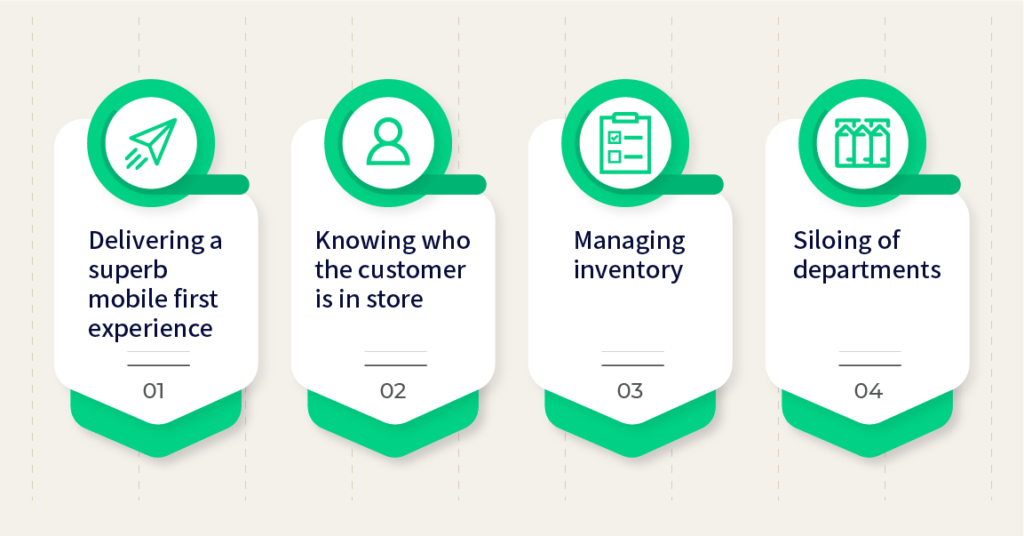The retail world knows very well that the shopping experience is one increasingly intertwined with technology. Yet it may surprise some that only about 18% of global consumer retail spending—even after the start of the pandemic—occurs online. But that rate is indeed growing—and fast.
Additionally, a significant (but difficult to measure) portion of retail may close in a brick-and-mortar store but begins online. This implies a profound element of the shopping experience all too often lost on retailers: A well-appointed store staffed with friendly-faces is no longer enough to ensure your retail brand’s success and positive reputation. Today you must also tend to your online presence.
Indeed, whether you’re a small retailer or the leader of a multi-national chain, the importance of a properly executed online strategy in our modern retail landscape simply cannot be overstated.
Brick-and-mortar: Technology improves traditional shopping
Stores that don’t sell online may think they don’t have to care about their online presence, but that is a mistake. At the most basic level, they need to make sure their customers can find them. The minimum is to ensure a clear google business listing with the correct information address, phone number, and hours. But to differentiate from the competition and get customers through the door, a clear, professional, mobile-friendly website with all that information plus the store’s story and inventory can better engage with people and tell them why they should come out to shop.
E-commerce & video commerce: Staking a place in the future of retail
In the US, 77.3% of customers have purchased something online, and e-commerce is an increasingly dominant way to reach customers. However, experienced retailers know making a sale online is a lot more complicated than just “opening a website.” When selling online, you are not just competing with the local stores in your area; you are competing with Amazon and Walmart. In addition, the logistics that need to be managed are incredibly complicated, especially as the big brands shape customer expectations to expect constant tracking and information available at their fingertips.
The only way to be successful is to differentiate with next-level service and a flawless customer experience. Of course, part of that is a flawless app and shopping experience – whether on desktop or, increasingly, on mobile.
Omnichannel retail: An immersive experience
The best retail ecosystem is neither online nor in-store. It is both. An integrated system of online shopping and information with in-store shopping and service pulls customers in from every angle. Customers can buy online in the middle of the night and not worry about expensive return shipping if they can bring the item back to the store. While there, they may buy a few things on impulse. It goes the other way too. If a customer sees a product in a retail store that is temporarily out of stock, they may be tempted to pull out their phone and buy it on Amazon. To compete, the store needs to make it easy to buy it from their own website to close the deal.
This type of ecosystem is difficult to build up, but it can be the backbone of deep, invaluable customer loyalty if it is properly executed. The logistics involved in tracking a customer across multiple stores, an app, and a website are difficult to manage, and retailers need to innovate to stay on top of trends constantly. This complex of a system can’t just be set and forgotten; it needs to be updated and innovated continually. However, when it is done right, the payoff can mean a lifetime of loyalty and purchases.
The problems

But whether you are working with a legacy system or starting from scratch, all retailers that attempt to create an immersive shopping experience struggle with issues such as
- Delivering a superb mobile first experience
The above trends strongly suggest that mobile is a crucial core component for any retailer’s strategy today. However, with the plethora of options available to consumers, delivering a kickass mobile experience which can attract, convert, engage, and retain customers is getting increasingly difficult with time.
2. Knowing who the customer is in store
You can create an app or loyalty program, but if there are any delays, bugs, or barriers to using it at checkout, customers are likely just to skip it. In addition, it is difficult to match the convenience of just swiping a credit card, so retailers need to find creative ways to know who is shopping in their stores.
3. Managing inventory
Retailers desperately do not want to bring a customer through the entire process of marketing, acquisition, and selling them a product only to find out that their order is out of stock. Not only do they lose out on an order, but it also leaves the customer with a bad impression. For a small shop that fills its online orders from a retail store, it is a considerable challenge to keep track of in store-inventory online in real-time.
4. Siloing of departments
For traditional companies with legacy infrastructure, the siloing of different parts of a retail organization (whether it’s various departments or online vs. in-store) can make it incredibly challenging to create an integrated experience. To get buy-in from employees at every level, new technology must make their jobs easier, not harder
The Solution
While the challenges facing modern retail are diverse (and our analysis is far from comprehensive), many of them can be solved with resilient, integrated, modern technology. Because these systems are so vast and complicated and touch every part of the customer experience, it is crucial for them to be flawless and constantly tested. If not, they may do more harm than good. For companies with a limited budget, this can be daunting. Sofy can help. Our no-code testing platform and library of real devices means that QA testing can run while you’re working on other things.
- Real Device Testing
- Run Manual & Ad-Hoc tests
- No-Code Automation
- Integrated in your Dev Stack
If your QA resources are limited but you still need a flawless customer experience, you need Sofy. Sofy supercharges automated, manual, and ad-hoc testing. We offer real devices for fidelity, no-code automation for resiliency, optimized manual testing for speed, and full integration into your DevOps.










